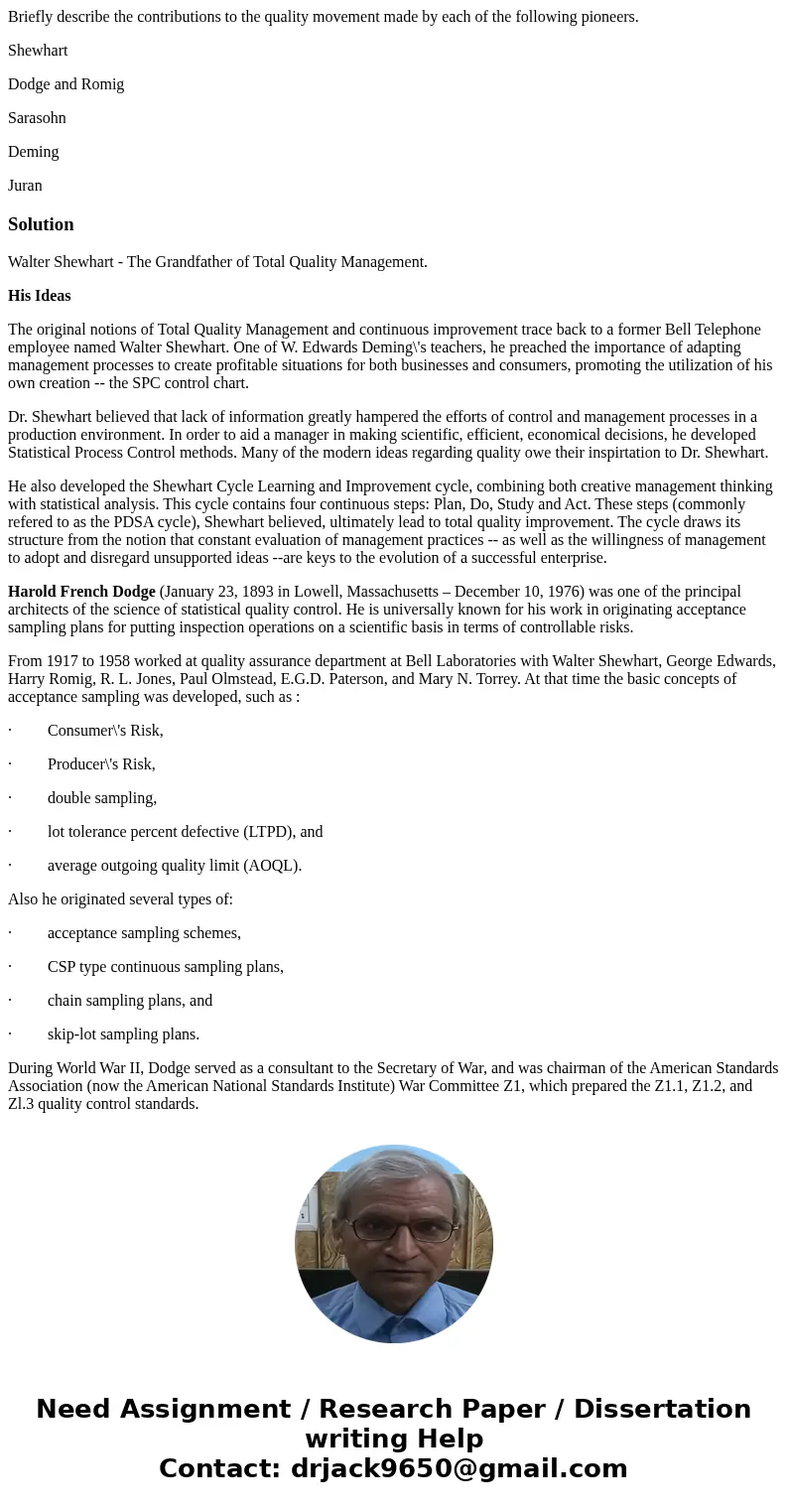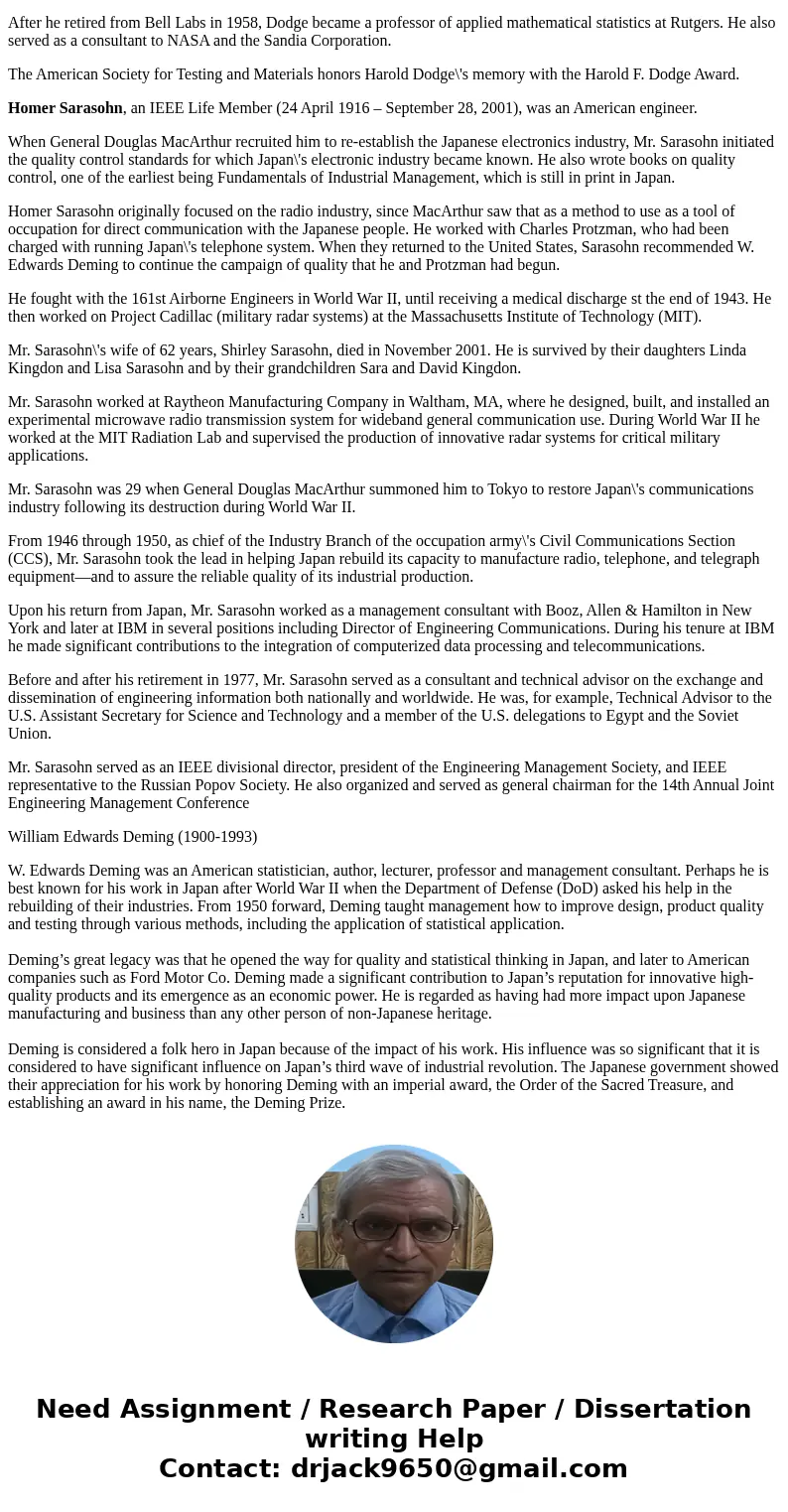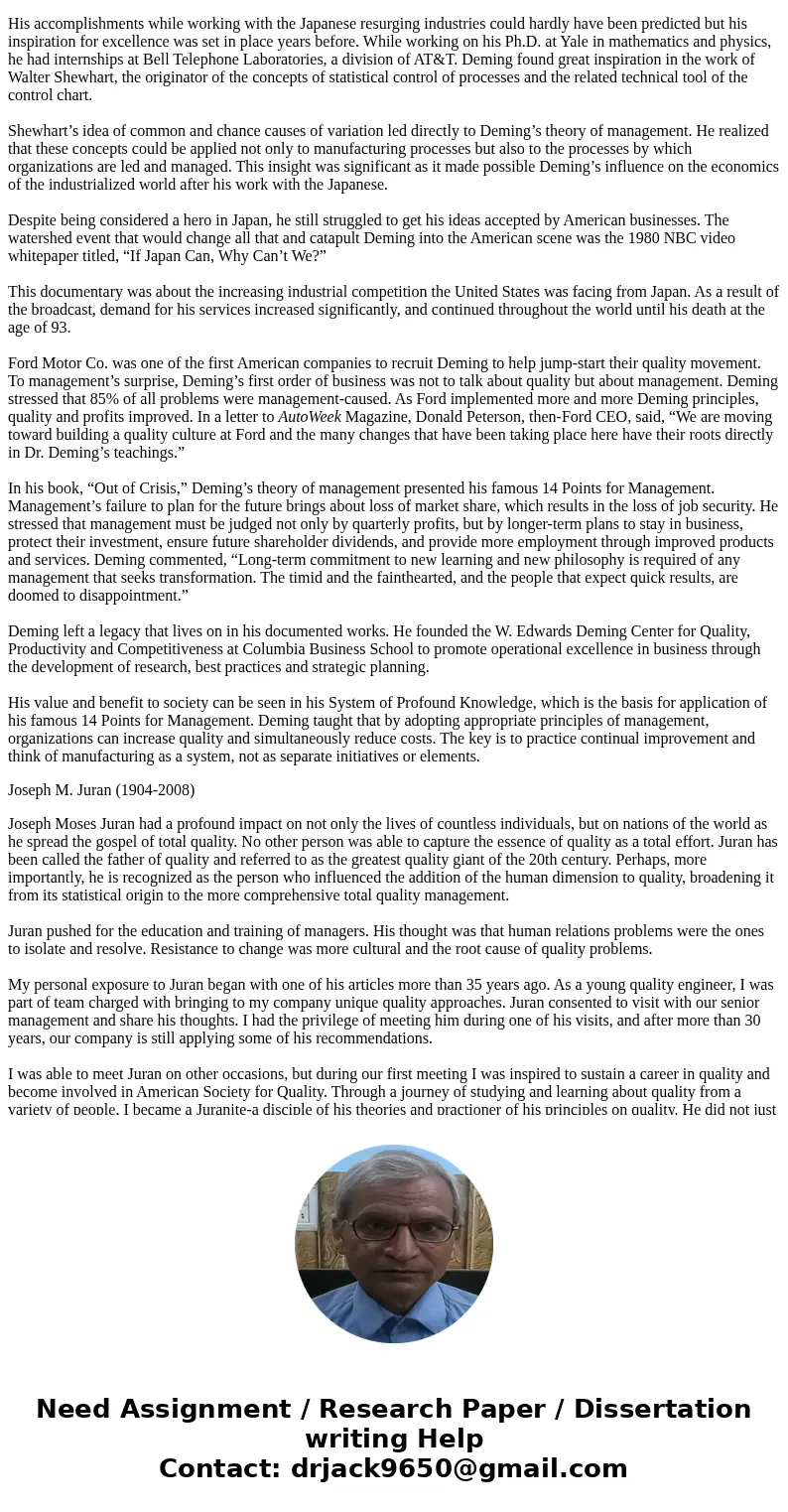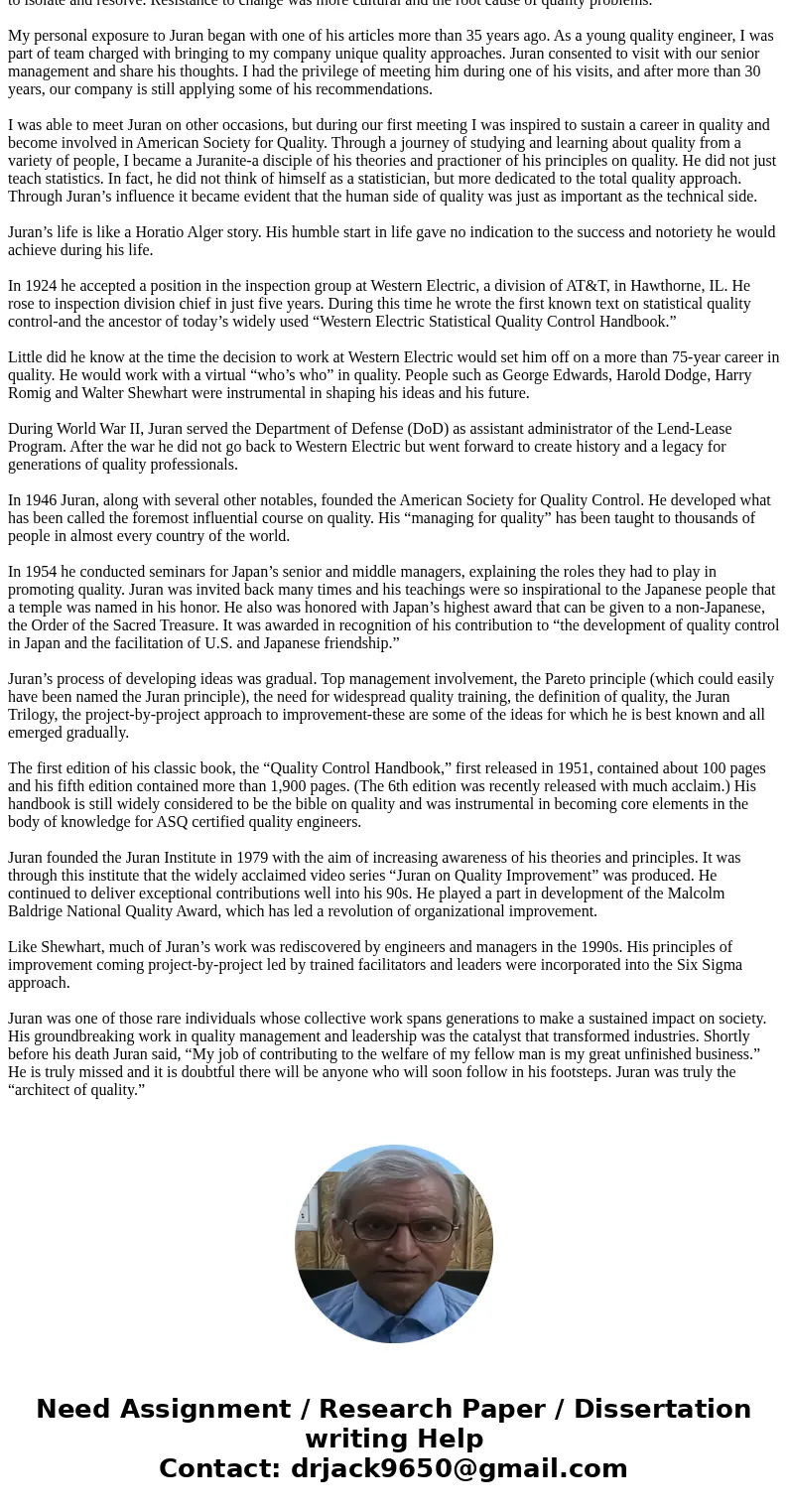Briefly describe the contributions to the quality movement m
Briefly describe the contributions to the quality movement made by each of the following pioneers.
Shewhart
Dodge and Romig
Sarasohn
Deming
Juran
Solution
Walter Shewhart - The Grandfather of Total Quality Management.
His Ideas
The original notions of Total Quality Management and continuous improvement trace back to a former Bell Telephone employee named Walter Shewhart. One of W. Edwards Deming\'s teachers, he preached the importance of adapting management processes to create profitable situations for both businesses and consumers, promoting the utilization of his own creation -- the SPC control chart.
Dr. Shewhart believed that lack of information greatly hampered the efforts of control and management processes in a production environment. In order to aid a manager in making scientific, efficient, economical decisions, he developed Statistical Process Control methods. Many of the modern ideas regarding quality owe their inspirtation to Dr. Shewhart.
He also developed the Shewhart Cycle Learning and Improvement cycle, combining both creative management thinking with statistical analysis. This cycle contains four continuous steps: Plan, Do, Study and Act. These steps (commonly refered to as the PDSA cycle), Shewhart believed, ultimately lead to total quality improvement. The cycle draws its structure from the notion that constant evaluation of management practices -- as well as the willingness of management to adopt and disregard unsupported ideas --are keys to the evolution of a successful enterprise.
Harold French Dodge (January 23, 1893 in Lowell, Massachusetts – December 10, 1976) was one of the principal architects of the science of statistical quality control. He is universally known for his work in originating acceptance sampling plans for putting inspection operations on a scientific basis in terms of controllable risks.
From 1917 to 1958 worked at quality assurance department at Bell Laboratories with Walter Shewhart, George Edwards, Harry Romig, R. L. Jones, Paul Olmstead, E.G.D. Paterson, and Mary N. Torrey. At that time the basic concepts of acceptance sampling was developed, such as :
· Consumer\'s Risk,
· Producer\'s Risk,
· double sampling,
· lot tolerance percent defective (LTPD), and
· average outgoing quality limit (AOQL).
Also he originated several types of:
· acceptance sampling schemes,
· CSP type continuous sampling plans,
· chain sampling plans, and
· skip-lot sampling plans.
During World War II, Dodge served as a consultant to the Secretary of War, and was chairman of the American Standards Association (now the American National Standards Institute) War Committee Z1, which prepared the Z1.1, Z1.2, and Zl.3 quality control standards.
After he retired from Bell Labs in 1958, Dodge became a professor of applied mathematical statistics at Rutgers. He also served as a consultant to NASA and the Sandia Corporation.
The American Society for Testing and Materials honors Harold Dodge\'s memory with the Harold F. Dodge Award.
Homer Sarasohn, an IEEE Life Member (24 April 1916 – September 28, 2001), was an American engineer.
When General Douglas MacArthur recruited him to re-establish the Japanese electronics industry, Mr. Sarasohn initiated the quality control standards for which Japan\'s electronic industry became known. He also wrote books on quality control, one of the earliest being Fundamentals of Industrial Management, which is still in print in Japan.
Homer Sarasohn originally focused on the radio industry, since MacArthur saw that as a method to use as a tool of occupation for direct communication with the Japanese people. He worked with Charles Protzman, who had been charged with running Japan\'s telephone system. When they returned to the United States, Sarasohn recommended W. Edwards Deming to continue the campaign of quality that he and Protzman had begun.
He fought with the 161st Airborne Engineers in World War II, until receiving a medical discharge st the end of 1943. He then worked on Project Cadillac (military radar systems) at the Massachusetts Institute of Technology (MIT).
Mr. Sarasohn\'s wife of 62 years, Shirley Sarasohn, died in November 2001. He is survived by their daughters Linda Kingdon and Lisa Sarasohn and by their grandchildren Sara and David Kingdon.
Mr. Sarasohn worked at Raytheon Manufacturing Company in Waltham, MA, where he designed, built, and installed an experimental microwave radio transmission system for wideband general communication use. During World War II he worked at the MIT Radiation Lab and supervised the production of innovative radar systems for critical military applications.
Mr. Sarasohn was 29 when General Douglas MacArthur summoned him to Tokyo to restore Japan\'s communications industry following its destruction during World War II.
From 1946 through 1950, as chief of the Industry Branch of the occupation army\'s Civil Communications Section (CCS), Mr. Sarasohn took the lead in helping Japan rebuild its capacity to manufacture radio, telephone, and telegraph equipment—and to assure the reliable quality of its industrial production.
Upon his return from Japan, Mr. Sarasohn worked as a management consultant with Booz, Allen & Hamilton in New York and later at IBM in several positions including Director of Engineering Communications. During his tenure at IBM he made significant contributions to the integration of computerized data processing and telecommunications.
Before and after his retirement in 1977, Mr. Sarasohn served as a consultant and technical advisor on the exchange and dissemination of engineering information both nationally and worldwide. He was, for example, Technical Advisor to the U.S. Assistant Secretary for Science and Technology and a member of the U.S. delegations to Egypt and the Soviet Union.
Mr. Sarasohn served as an IEEE divisional director, president of the Engineering Management Society, and IEEE representative to the Russian Popov Society. He also organized and served as general chairman for the 14th Annual Joint Engineering Management Conference
William Edwards Deming (1900-1993)
W. Edwards Deming was an American statistician, author, lecturer, professor and management consultant. Perhaps he is best known for his work in Japan after World War II when the Department of Defense (DoD) asked his help in the rebuilding of their industries. From 1950 forward, Deming taught management how to improve design, product quality and testing through various methods, including the application of statistical application.
Deming’s great legacy was that he opened the way for quality and statistical thinking in Japan, and later to American companies such as Ford Motor Co. Deming made a significant contribution to Japan’s reputation for innovative high-quality products and its emergence as an economic power. He is regarded as having had more impact upon Japanese manufacturing and business than any other person of non-Japanese heritage.
Deming is considered a folk hero in Japan because of the impact of his work. His influence was so significant that it is considered to have significant influence on Japan’s third wave of industrial revolution. The Japanese government showed their appreciation for his work by honoring Deming with an imperial award, the Order of the Sacred Treasure, and establishing an award in his name, the Deming Prize.
His accomplishments while working with the Japanese resurging industries could hardly have been predicted but his inspiration for excellence was set in place years before. While working on his Ph.D. at Yale in mathematics and physics, he had internships at Bell Telephone Laboratories, a division of AT&T. Deming found great inspiration in the work of Walter Shewhart, the originator of the concepts of statistical control of processes and the related technical tool of the control chart.
Shewhart’s idea of common and chance causes of variation led directly to Deming’s theory of management. He realized that these concepts could be applied not only to manufacturing processes but also to the processes by which organizations are led and managed. This insight was significant as it made possible Deming’s influence on the economics of the industrialized world after his work with the Japanese.
Despite being considered a hero in Japan, he still struggled to get his ideas accepted by American businesses. The watershed event that would change all that and catapult Deming into the American scene was the 1980 NBC video whitepaper titled, “If Japan Can, Why Can’t We?”
This documentary was about the increasing industrial competition the United States was facing from Japan. As a result of the broadcast, demand for his services increased significantly, and continued throughout the world until his death at the age of 93.
Ford Motor Co. was one of the first American companies to recruit Deming to help jump-start their quality movement. To management’s surprise, Deming’s first order of business was not to talk about quality but about management. Deming stressed that 85% of all problems were management-caused. As Ford implemented more and more Deming principles, quality and profits improved. In a letter to AutoWeek Magazine, Donald Peterson, then-Ford CEO, said, “We are moving toward building a quality culture at Ford and the many changes that have been taking place here have their roots directly in Dr. Deming’s teachings.”
In his book, “Out of Crisis,” Deming’s theory of management presented his famous 14 Points for Management. Management’s failure to plan for the future brings about loss of market share, which results in the loss of job security. He stressed that management must be judged not only by quarterly profits, but by longer-term plans to stay in business, protect their investment, ensure future shareholder dividends, and provide more employment through improved products and services. Deming commented, “Long-term commitment to new learning and new philosophy is required of any management that seeks transformation. The timid and the fainthearted, and the people that expect quick results, are doomed to disappointment.”
Deming left a legacy that lives on in his documented works. He founded the W. Edwards Deming Center for Quality, Productivity and Competitiveness at Columbia Business School to promote operational excellence in business through the development of research, best practices and strategic planning.
His value and benefit to society can be seen in his System of Profound Knowledge, which is the basis for application of his famous 14 Points for Management. Deming taught that by adopting appropriate principles of management, organizations can increase quality and simultaneously reduce costs. The key is to practice continual improvement and think of manufacturing as a system, not as separate initiatives or elements.
Joseph M. Juran (1904-2008)
Joseph Moses Juran had a profound impact on not only the lives of countless individuals, but on nations of the world as he spread the gospel of total quality. No other person was able to capture the essence of quality as a total effort. Juran has been called the father of quality and referred to as the greatest quality giant of the 20th century. Perhaps, more importantly, he is recognized as the person who influenced the addition of the human dimension to quality, broadening it from its statistical origin to the more comprehensive total quality management.
Juran pushed for the education and training of managers. His thought was that human relations problems were the ones to isolate and resolve. Resistance to change was more cultural and the root cause of quality problems.
My personal exposure to Juran began with one of his articles more than 35 years ago. As a young quality engineer, I was part of team charged with bringing to my company unique quality approaches. Juran consented to visit with our senior management and share his thoughts. I had the privilege of meeting him during one of his visits, and after more than 30 years, our company is still applying some of his recommendations.
I was able to meet Juran on other occasions, but during our first meeting I was inspired to sustain a career in quality and become involved in American Society for Quality. Through a journey of studying and learning about quality from a variety of people, I became a Juranite-a disciple of his theories and practioner of his principles on quality. He did not just teach statistics. In fact, he did not think of himself as a statistician, but more dedicated to the total quality approach. Through Juran’s influence it became evident that the human side of quality was just as important as the technical side.
Juran’s life is like a Horatio Alger story. His humble start in life gave no indication to the success and notoriety he would achieve during his life.
In 1924 he accepted a position in the inspection group at Western Electric, a division of AT&T, in Hawthorne, IL. He rose to inspection division chief in just five years. During this time he wrote the first known text on statistical quality control-and the ancestor of today’s widely used “Western Electric Statistical Quality Control Handbook.”
Little did he know at the time the decision to work at Western Electric would set him off on a more than 75-year career in quality. He would work with a virtual “who’s who” in quality. People such as George Edwards, Harold Dodge, Harry Romig and Walter Shewhart were instrumental in shaping his ideas and his future.
During World War II, Juran served the Department of Defense (DoD) as assistant administrator of the Lend-Lease Program. After the war he did not go back to Western Electric but went forward to create history and a legacy for generations of quality professionals.
In 1946 Juran, along with several other notables, founded the American Society for Quality Control. He developed what has been called the foremost influential course on quality. His “managing for quality” has been taught to thousands of people in almost every country of the world.
In 1954 he conducted seminars for Japan’s senior and middle managers, explaining the roles they had to play in promoting quality. Juran was invited back many times and his teachings were so inspirational to the Japanese people that a temple was named in his honor. He also was honored with Japan’s highest award that can be given to a non-Japanese, the Order of the Sacred Treasure. It was awarded in recognition of his contribution to “the development of quality control in Japan and the facilitation of U.S. and Japanese friendship.”
Juran’s process of developing ideas was gradual. Top management involvement, the Pareto principle (which could easily have been named the Juran principle), the need for widespread quality training, the definition of quality, the Juran Trilogy, the project-by-project approach to improvement-these are some of the ideas for which he is best known and all emerged gradually.
The first edition of his classic book, the “Quality Control Handbook,” first released in 1951, contained about 100 pages and his fifth edition contained more than 1,900 pages. (The 6th edition was recently released with much acclaim.) His handbook is still widely considered to be the bible on quality and was instrumental in becoming core elements in the body of knowledge for ASQ certified quality engineers.
Juran founded the Juran Institute in 1979 with the aim of increasing awareness of his theories and principles. It was through this institute that the widely acclaimed video series “Juran on Quality Improvement” was produced. He continued to deliver exceptional contributions well into his 90s. He played a part in development of the Malcolm Baldrige National Quality Award, which has led a revolution of organizational improvement.
Like Shewhart, much of Juran’s work was rediscovered by engineers and managers in the 1990s. His principles of improvement coming project-by-project led by trained facilitators and leaders were incorporated into the Six Sigma approach.
Juran was one of those rare individuals whose collective work spans generations to make a sustained impact on society. His groundbreaking work in quality management and leadership was the catalyst that transformed industries. Shortly before his death Juran said, “My job of contributing to the welfare of my fellow man is my great unfinished business.” He is truly missed and it is doubtful there will be anyone who will soon follow in his footsteps. Juran was truly the “architect of quality.”




 Homework Sourse
Homework Sourse